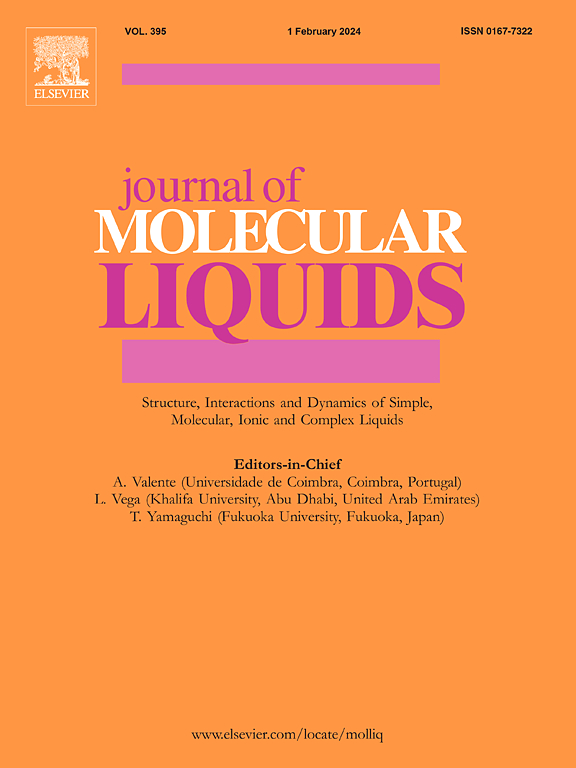从废物中提取的低熔点混合物,作为黑色物质加工的浸出剂
IF 5.3
2区 化学
Q2 CHEMISTRY, PHYSICAL
引用次数: 0
摘要
寻找合适的溶剂冶金法替代传统湿法冶金法,从废锂离子电池中提取关键元素,如Li, Co, Ni和Mn混合黑质(BM),是一个重要的目标。这种方法虽然在实验室规模上有效,但在应用于典型的大批量工业生产时缺乏可持续性。本文介绍了两种浸出剂的循环制备方法。从回收的废食用油开始,经过化学水解得到甘油和长链游离脂肪酸(FFAs)的混合物。将甘油与水(1:3 M)混合,得到低粘度的浸出介质,将游离脂肪酸与薄荷醇混合,得到一套低熔点混合物。通过DFT计算和1H NMR谱法测定了它们的共晶组成。两种体系都作为浸出剂进行了测试,以处理混合BM,显示出良好的锂去除率和选择性。本文章由计算机程序翻译,如有差异,请以英文原文为准。
Low melting mixtures from waste as leaching agents for black mass processing
The search for suitable solvometallurgy alternatives to classic hydrometallurgy for the extraction of critical elements such as Li, Co, Ni, and Mn mixed Black Mass (BM) obtained from spent Li-ion batteries is a target of primary importance. This approach, although effective at the laboratory scale, lacks sustainability when applied to the large volumes typical of industrial productions. Herein, a circular fabrication of two leaching agents is presented. Starting from waste cooking oils, which were recycled and subjected to chemical hydrolysis, glycerol and a mixture of long-chain Free Fatty Acids (FFAs) were obtained. The glycerol was mixed with water (1:3 M ratio) to obtain a leaching medium with low viscosity, while the FFAs were combined with menthol to produce a set of low melting mixtures. The determination of their eutectic composition was achieved by DFT calculations and 1H NMR spectroscopy. Both systems were tested as leaching agents for processing a mixed BM showing promising lithium removal rates and selectivity.
求助全文
通过发布文献求助,成功后即可免费获取论文全文。
去求助
来源期刊

Journal of Molecular Liquids
化学-物理:原子、分子和化学物理
CiteScore
10.30
自引率
16.70%
发文量
2597
审稿时长
78 days
期刊介绍:
The journal includes papers in the following areas:
– Simple organic liquids and mixtures
– Ionic liquids
– Surfactant solutions (including micelles and vesicles) and liquid interfaces
– Colloidal solutions and nanoparticles
– Thermotropic and lyotropic liquid crystals
– Ferrofluids
– Water, aqueous solutions and other hydrogen-bonded liquids
– Lubricants, polymer solutions and melts
– Molten metals and salts
– Phase transitions and critical phenomena in liquids and confined fluids
– Self assembly in complex liquids.– Biomolecules in solution
The emphasis is on the molecular (or microscopic) understanding of particular liquids or liquid systems, especially concerning structure, dynamics and intermolecular forces. The experimental techniques used may include:
– Conventional spectroscopy (mid-IR and far-IR, Raman, NMR, etc.)
– Non-linear optics and time resolved spectroscopy (psec, fsec, asec, ISRS, etc.)
– Light scattering (Rayleigh, Brillouin, PCS, etc.)
– Dielectric relaxation
– X-ray and neutron scattering and diffraction.
Experimental studies, computer simulations (MD or MC) and analytical theory will be considered for publication; papers just reporting experimental results that do not contribute to the understanding of the fundamentals of molecular and ionic liquids will not be accepted. Only papers of a non-routine nature and advancing the field will be considered for publication.
 求助内容:
求助内容: 应助结果提醒方式:
应助结果提醒方式:


